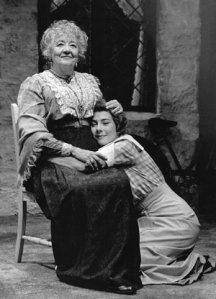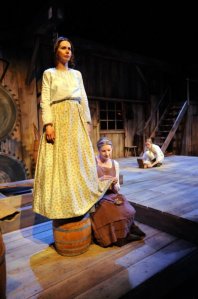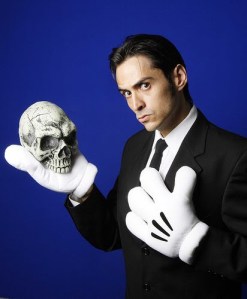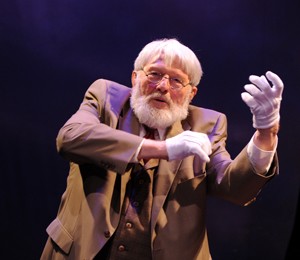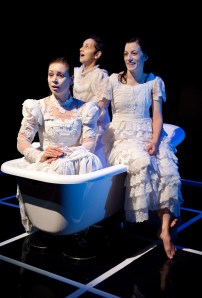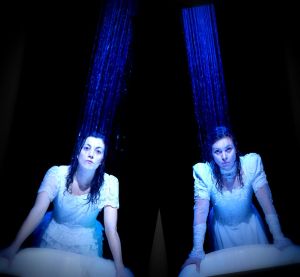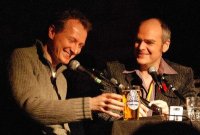Matthew Shepard’s name has become synonymous with the Hate Crimes Prevention Act that bears his name, as well as with the play The Laramie Project which premiered in February 2000. This year, a new play was written which included follow up interviews with residents of Laramie, Wyoming, Shepard’s mother Judy, as well as with his incarcerated killers. On October 12th, 2009, the 11th Anniversary of Matthew Shepard’s horrific and unjustifiable murder, there were approximately one hundred readings of the new play given in cities throughout the United States and Canada, including one at The Company House in Halifax and the Bread and Circus in Toronto (through Studio 180). One year ago Judy Shepard spoke to USA Today, speaking about the difference in American society between 1998 and 2008. She said, “What hasn’t is that hate crimes continue… we cannot let hate go unchecked in our schools and communities. Our young people need our direction and guidance to prevent this type of crime from happening.”
Of course, she is right, and what is even more terrifying is that there are still countless examples of adults, holding positions of power, and even supposed “esteem,” who perpetuate the myth that being gay somehow devalues a person’s life or who seek to sweep homophobia under the rug. These people are all silently complicit to the crimes committed that are motivated by hate. In May 2009, North Carolina Representative Virginia Foxx, an adult who is supposed to set a good example for the children in American schools and all citizens of North Carolina, publicly rebuffed Matthew Shepard’s death as a “hoax” refusing to believe that he was specifically targeted for his sexual orientation.
It’s easy to look backward at 1998 and say “oh, that was then (things are different now, we all watch Ellen). It’s easy to look at Wyoming and say, “oh, that’s just them (they’re rednecks, we’re not. We LOVE Ellen!). Less than a week ago I sat at Theatre Passe Muraille and watched BASH’d and I listened to the heartbreakingly long list of names of those who have died because of homophobia. I felt sympathetic, I felt saddened and ashamed, but I still felt like I lived in a place where we were all safe; a place that had reached a higher plain of equality because Toronto was a filthy, foul smelling buffet where everyone was welcome to come as they were. It NAUSEATES me that I was deluded in my false sense of progress.
I woke up this morning to the news that Christopher Skinner, a 27 year old gay resident of Toronto, soon to be married to his fiancé Ryan Cooke, had been brutally attacked by a group of men on the corner of Adelaide Street E. and Victoria St at 3:00am, beaten to the ground and run over by an SUV. He was taken to the hospital where he died of his injuries. Horror. Shock. Outrage. Some of you may have known Skinner, he loved Sharron Matthews and was the guy who would always yell for her to sing “One more song!” at Sharron’s Party. Brutally attacked and murdered. Twenty-seven years old. The police will not classify this case as a “hate crime” yet, or say that he was targeted for his sexual orientation, but I don’t care. Dave O’Malley was a self-described “homophobic” police officer in Laramie when Matthew Shepard was killed, who has since become a gay rights activist. He told USA Today earlier this year that he’s heard people say that Shepard’s death was “not a hate crime,” but simply a robbery or a botched drug deal, but he says, “They didn’t see Matt’s hairs embedded in the wooded butt of McKinney’s .357 Magnum pistol after the student—whose autopsy report noted he stood 5-foot-3 and weighed 105 pounds—was hit at least 18 times. To me, that’s hatred.” Similarly, to be beaten to the ground and then maliciously run over by a SUV is a vengeful action and one filled with malice.
Canadians are lucky to live in a country that is leading the way in equality for same sex couples; that is a fact that we cannot forget and that should fill us with pride. Yet, we cannot afford to become complacent when it is terrifyingly obvious that we have not won the fight for equality quite yet, no matter how boisterous and large the Pride Parade or how many happily married same-sex couples adopt children and live peacefully in Canadian neighborhoods. Homophobia still lingers and lurks throughout all the cities and towns of this country of ours and we have a responsibility to educate and to spread awareness and to demand that our politicians, our teachers, our police officers, our lawyers, and public officials, all the leaders of this country, act as responsible role models for our children and our citizens and advocate equality and denounce all physical, sexual and verbal abuse, especially when it is targeted against any one specific group.
I grew up in a Catholic School where I was taught, above all other doctrine, the Golden Rule: do to others what you would like to be done to you. The Director of my High School was so outraged by a 2002 news story that a Catholic School in Ontario would not allow one of their gay students to bring his boyfriend to their prom, that she came into our Grade 12 classroom specifically to tell us that we were welcome to invite anyone we wished to our prom and that our sexual orientation was our personal choice and it would have no impact on the way we were treated in school, or indeed by the Catholic Church within the school. By twelve years old (completely oblivious) I had successfully mastered the “fag hag” stereotype. In 2005 I saw a lesbian version of West Side Story (brilliantly directed and conceived by Raquel Duffy, currently a member of the Soulpepper Conservatory Program) performed at St. Matt’s United Church, where same-sex marriages were commonplace. By 2006, my 85 year old grandmother and I were watching reruns of Will & Grace.
In 2007, Grade Twelve students (18 year old boys) from Central Kings Rural High School (Annapolis Valley, Nova Scotia), David Shepherd and Travis Price, began an international anti-bullying movement, when they rallied support for a grade nine student who had been targeted by bullies when he wore a pink shirt on the first day of school. Reports maintain that these bullies had called the student a “homosexual” and threatened to beat him up. Shepherd and Price urged their friends and classmates to wear pink shirts the following day to show their intolerance for bullying and homophobia. At eighteen years old, these boys were showing more class, social conscience and activism than many of the leaders of their government!
Of the fifty states in the United States of America, there are only four where same-sex couples can legally get married. Yesterday Brad Fraser posted a link to a news story from Miami about a woman named Lisa Pond who died in a hospital alone, while her partner, Janice Langbehn and her three adopted children, sat in the waiting room because the officials at Jackson Memorial Hospital would not recognize them as “family members” and admit them to Pond’s hospital room because Pond and Langbehn, who had been together for eighteen years, were gay. Of course, those who preach about the sanctity of “marriage” and those who follow a policy which devalues the relationships of same-sex couples more often than not do no condone the type of hate crime that killed Matthew Shepard. Yet, every action that draws an “us and them” line in the sand, every step away from equality, generates the climate out of which homophobia will rear its ugly head. If the American government is giving every indication that to be gay requires some “other” policy, some “other” word, they are pitting American citizens against one another. As soon as religion and/or fear enters the fray, the climate becomes ripe for violence.
I mistakenly thought that my blithe little life, largely ignorant to prejudice at home, at school, and (remarkably) in church, was a common Canadian occurrence. It doesn’t matter. It is all of our responsibility to fight for equality in the world of which we are all citizens. Earlier this month members of the Broadway community, led by Gavin Creel, Sutton Foster, Audra McDonald, Cynthia Nixon and David Stone, participated in a National Equality March on Washington DC demanding that their Senators pass the Marriage Equality Bill (S:4401). These Broadway stars even arranged buses to transport Equality Supporters to the march.
I think we need to demand more of our city, to insure not only that crimes like the one that killed Christopher Skinner are eradicated, but also that our community is rallied together by a healthy and constructive sense of outrage and to actively condemn such hatred. We need to demand more of the “Leader of the Free World,” The United States, whose media dominates the world and whose leaders make so many of the decisions that affect us all. The United States needs to earn its position of global superpower by proving that it has the integrity required to truly lead our planet in the generations to come. I think we as Canadians have a responsibility to help and support our American contemporaries in their fight for equality and in their fight against homophobia and to put an end to their rich history of prejudice, intolerance and hate-driven crimes.
We need to stop being quiet. We need to stop feeling too small, feeling too overwhelmed, feeling inadequate. We need to rise to the challenge that has been thrust upon us. Keep feeling outraged. Keep thinking critically. Keep writing blogs. Keep emailing politicians. Keep yelling our dissent, and forcing elections and marching in tandem, and singing our songs, and writing our plays, and singing in streets, supporting one another and believing that some day Matthew Shepard’s (and Christopher Skinner’s) death will seem every bit as foreign, bizarre and barbaric to every single beautiful bright-eyed child of tomorrow as the thought of sitting drinking ale watching a Christian get devoured by a lion seems to us.

